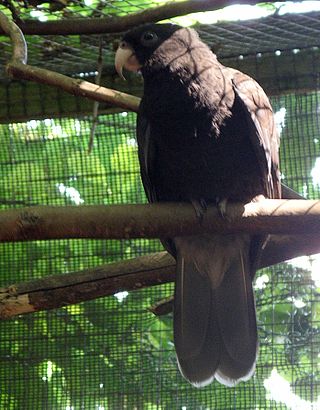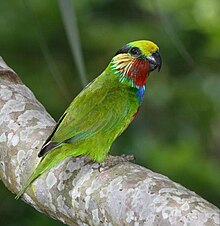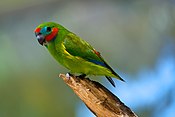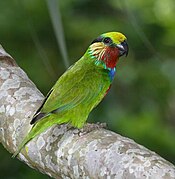
The family Psittacidae or holotropical parrots is one of three families of true parrots. It comprises the roughly 10 species of subfamily Psittacinae and 157 of subfamily Arinae, as well as several species that have gone extinct in recent centuries. Some of the most iconic birds in the world are represented here, such as the blue-and-gold macaw among the New World parrots and the grey parrot among the Old World parrots.

The genus Nestor is one of the two extant genera of the parrot family Strigopidae. Together with the kākāpō, and the extinct parrots in the genus Nelepsittacus, they form the parrot superfamily Strigopoidea. The genus Nestor contains two extant parrot species from New Zealand and two extinct species from Norfolk Island, Australia and Chatham Island, New Zealand, respectively. All species are large stocky birds with short squarish tails. A defining characteristic of the genus is the tongue, which is tipped with a hair-like fringe. The superficial resemblance of this tongue to that of lorikeets has led some taxonomists to consider the two groups closely related, but DNA evidence shows they are not.

The true parrots are about 350 species of hook-billed, mostly herbivorous birds forming the two superfamilies Psittacoidea, and Psittaculidae, two of the three superfamilies in the biological order Psittaciformes (parrots). True parrots are widespread, with species in Mexico, Central and South America, sub-Saharan Africa, India, Southeast Asia, Australia, and eastwards across the Pacific Ocean as far as Polynesia. The true parrots include many of the familiar parrots including macaws, conures, lorikeets, eclectus, Amazon parrots, grey parrot, and budgerigar. Most true parrots are colourful and flighted, with a few notable exceptions.

Loriini is a tribe of small to medium-sized arboreal parrots characterized by their specialized brush-tipped tongues for feeding on nectar of various blossoms and soft fruits, preferably berries. The species form a monophyletic group within the parrot family Psittaculidae. The group consists of the lories and lorikeets. Traditionally, they were considered a separate subfamily (Loriinae) from the other subfamily (Psittacinae) based on the specialized characteristics, but recent molecular and morphological studies show that the group is positioned in the middle of various other groups. They are widely distributed throughout the Australasian region, including south-eastern Asia, Polynesia, Papua New Guinea, Timor Leste and Australia, and the majority have very brightly coloured plumage.

Platycercinae is a subfamily of birds belonging to the family Psittaculidae that inhabit Oceania. It consists of two tribes, the ground parrots and allies (Pezoporini) and the many species of broad-tailed parrot (Platycercini).

Loriinae is a subfamily of psittacine birds, one of the five subfamilies that make up the family Psittaculidae. It consists of three tribes, the lories and lorikeets (Loriini), the budgerigar (Melopsittacini) and the fig parrots (Cyclopsittini), which are small birds, mostly of bright colors and inhabitants of Oceania and the islands of Southeast Asia.

The vasa parrots (Coracopsis) are four species of parrot which are endemic to Madagascar and other islands in the western Indian Ocean. Some taxonomists formerly placed the genus in Mascarinus, but this is now thought to be based on the results of a heavily flawed, later-debunked genetic study.

The lesser vasa parrot or black parrot is a black coloured parrot endemic to most of Madagascar. It is one of four species of vasa parrots, the others being the greater vasa parrot, the Seychelles black parrot, and the Comoros black parrot. The latter two were formerly considered conspecific with the lesser vasa parrot.

The Seychelles parakeet or Seychelles Island parrot is an extinct species of parrot that was endemic to the Seychelles in the Indian Ocean. It was scientifically named Palaeornis wardi by the British ornithologist Edward Newton in 1867, and the specific name honours the British civil commissioner Swinburne Ward who procured the specimens that formed the basis for the description. It was found on the islands of Mahé, Silhouette, and possibly Praslin. Ten skin specimens exist today, but no skeletons. Though it was later moved to the genus Psittacula, genetic studies have led some researchers to suggest it should belong in a reinstated Palaeornis along with the closely related Alexandrine parakeet of Asia.

The neotropical parrots or New World parrots comprise about 150 species in 32 genera found throughout South and Central America, Mexico, the Caribbean islands and (formerly) the southern United States. Among them are some of the most familiar and iconic parrots, including the blue and gold macaw, sun conure, and yellow-headed amazon.

The genus Polytelis of the family Psittaculidae consists of three species long-tailed parrot endemic to Australia. Traditionally, it was included in the Australian broad-tailed parrots, but molecular studies place the genus within the Polytelini.

The blue-fronted fig parrot is a species of parrot in the family Psittaculidae. It is found in Salawati and the Bird's Head Peninsula in New Guinea. Its natural habitat is subtropical or tropical moist lowland forests.

The large fig parrot, also known as flame-headed fig parrot and Desmarest's fig parrot, is a species of parrot in the family Psittaculidae. It is found in the West Papuan Islands, Indonesia and in southern and western New Guinea.

Psittaculirostris is a genus of parrots in the family Psittaculidae found in Indonesia and Papua New Guinea.

Edwards's fig parrot, also known as the scarlet-cheeked fig parrot, is a species of parrot in the family Psittaculidae found in humid lowland forests in north-eastern New Guinea. The adult male is predominantly green with red breast and cheeks, yellow ear coverts, and yellowish crown.

Parrots, also known as psittacines, are birds of the roughly 398 species in 92 genera comprising the order Psittaciformes, found mostly in tropical and subtropical regions. The order is subdivided into three superfamilies: the Psittacoidea, the Cacatuoidea (cockatoos), and the Strigopoidea. One-third of all parrot species are threatened by extinction, with higher aggregate extinction risk than any other comparable bird group. Parrots have a generally pantropical distribution with several species inhabiting temperate regions in the Southern Hemisphere, as well. The greatest diversity of parrots is in South America and Australasia.

Psittrichasiidae is a family of birds belonging to the superfamily of the true parrots (Psittacoidea). It is a very small family, the smallest of the three families of the true parrots. It is divided into two subfamilies: Psittrichasinae and Coracopsinae, that contain a single genus each. The first contains a single species, native to New Guinea, and the second contains four living species distributed throughout Madagascar and other islands of the Indian Ocean.

The Polytelini tribe belongs to the parrot family Psittaculidae and consists of three genera.

Agapornithinae is a subfamily of psittacine birds, one of the five subfamilies that make up the family Psittaculidae. Its members are small, short-tailed parrots that inhabit Africa and Asia. They usually have predominantly green plumage and present different colorations on the head.



















